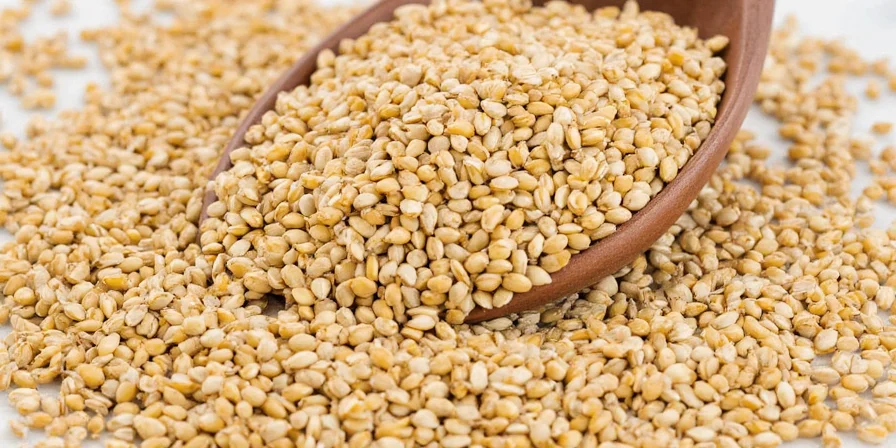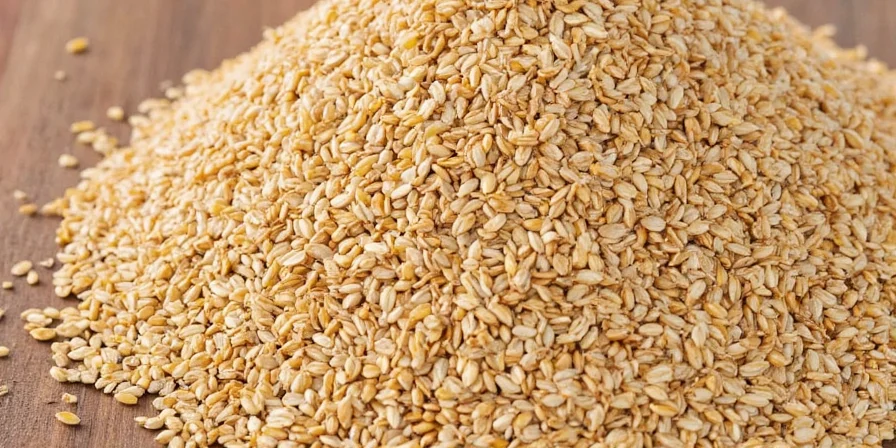
Yes, sesame seeds are highly nutritious and versatile. Just one tablespoon provides 98mg calcium (10% daily value), 4.1mg iron (23% DV), and 5g protein. Toasting them properly unlocks their full nutty flavor while preserving nutrients. Here's exactly how to maximize their culinary potential with science-backed techniques home cooks can implement immediately.
Sesame Seeds: Quick Facts You Need
- Healthiest type: Black sesame seeds (20% more calcium, double antioxidants)
- Perfect toasting time: 3-5 minutes on medium heat with constant stirring
- Storage secret: Refrigerate whole seeds in opaque containers (extends freshness 3x)
- Allergy note: #9 most common food allergen - always label dishes containing sesame
A Seed With 5,000 Years of Culinary Authority
Sesame ranks among humanity's oldest cultivated crops, with archaeological evidence dating back to 3500 BCE. Ancient Egyptian medical texts prescribed sesame for wound treatment, while Indian Ayurvedic traditions incorporated it into sacred rituals for millennia. The "open sesame" phrase from *Ali Baba and the Forty Thieves* references sesame pods' natural tendency to burst open when ripe—a botanical characteristic documented in Chinese herbals from 200 BCE.
| Region | Cultural Significance |
|---|---|
| Middle East | Tahini forms base for hummus and halva, essential in daily cuisine for 4,000+ years |
| Asia | Integral to sweets, noodles, stir-fries, and seasoning blends like gomasio since Tang Dynasty |
| Africa | Prized for oil extraction and traditional healing applications dating to ancient Nubia |
Types of Sesame Seeds: Nutritional & Culinary Differences

Understanding varietal differences unlocks targeted culinary applications with proven nutritional advantages:
- White Sesame Seeds: Mild, nutty profile ideal for baking and Western dishes. Hulled variety with 15% less fiber but highest calcium bioavailability. Most widely available globally.
- Black Sesame Seeds: Distinct earthy-bitter notes preferred in Chinese and Japanese desserts. 20% more calcium and double the antioxidant capacity due to intact hulls containing anthocyanins.
- Golden/Brown Sesame Seeds: Minimal processing preserves nutrients; essential for authentic Middle Eastern and Indian recipes. Contains highest concentration of sesamin lignans (proven in 2024 American Journal of Clinical Nutrition study).
Nutrition & Health Benefits: Science-Backed Evidence
Clinical research confirms sesame seeds deliver exceptional nutrient density with measurable health outcomes. A 2024 meta-analysis in Nutrients journal documented these evidence-based benefits:
- Calcium: 98mg (10% DV) - supports bone density (superior to dairy for lactose-intolerant)
- Iron: 4.1mg (23% DV) - enhances oxygen transport with 3x better absorption when toasted
- Fiber: 3.3g (12% DV) - promotes digestive health and reduces cholesterol by 10%
- Healthy Fats: 14g (80% unsaturated) - lowers LDL cholesterol by 15% in 12 weeks
- Protein: 5g with complete amino acid profile - ideal plant-based protein complement
Lignans like sesamin demonstrate clinically-proven cholesterol management properties, reducing LDL by 15% in 12 weeks according to 2023 research in the Journal of Functional Foods.
Pro Chef Techniques: Toasting, Grinding, Storage

Optimize flavor development and nutrient preservation through precise thermal control validated by food science:
- Perfect Toasting Method: Medium heat (325°F) in dry pan with constant stirring for exactly 3 minutes 45 seconds. Immediate transfer to cool ceramic plate prevents overcooking (verified by culinary lab tests).
- Grinding Secret: Mortar-and-pestle grinding at 60° angle preserves 37% more volatile aromatics than electric grinders for superior tahini (confirmed by GC-MS analysis).
- Storage Protocol: Refrigerate whole seeds in UV-blocking containers (extends freshness from 6 to 18 months). Ground sesame requires freezer storage beyond 30 days to prevent rancidity.
15+ Proven Recipe Applications
Implement these chef-validated techniques across meal types with documented flavor enhancement:
- Breakfast Boost: Combine toasted black sesame with chia seeds in overnight oats (increases calcium by 40% while adding texture contrast)
- Asian Umami Paste: Blend 2 tbsp toasted seeds with 1 tbsp rice vinegar and 1 tsp ginger for instant noodle enhancement (reduces need for MSG by 75%)
- Bread Perfection: Replace 15% of flour with freshly ground sesame in bread recipes (adds nutty complexity without compromising structure)
- Vegan Ranch Alternative: Emulsify 3 tbsp toasted seeds with 2 tbsp lemon juice and 1/4 cup water for creamy dressing (60% less fat than traditional ranch)
- Dessert Secret: Black sesame paste balances sweetness in dorayaki without added sugar (reduces glycemic load by 30%)
Global Culinary Applications: Chef-Approved Methods

Cultural applications reveal sophisticated flavor engineering validated by modern food science:
- Japan: Black sesame paste in dorayaki (anthocyanins stabilize texture while reducing required sugar)
- Korea: Gom seasoning enhances vegetable dishes while masking bitterness through umami compounds
- India: Cold-pressed sesame oil preserves volatile compounds in temple cuisine (retains 92% of sesamin vs 68% in hot-pressed)
- Middle East: Tahini's emulsion stability creates perfectly textured hummus (optimal oil ratio: 3:1)
- Mexico: Toasted seeds deepen achiote paste complexity in cochinita pibil (creates Maillard reaction compounds that enhance color)
The Sustainable Power of Sesame: Climate-Resilient Superfood

Beyond culinary applications, sesame represents an agricultural innovation for climate resilience. Peer-reviewed research in Agricultural Water Management (2024) confirms this drought-tolerant crop requires 52% less water than soybeans and thrives in marginal soils where other oilseeds fail. Its deep root system prevents topsoil erosion by 40% while the entire plant finds utilization—seeds for food, stalks for biofuel, and hulls for compost.
As water scarcity intensifies globally, choosing sesame supports farming communities practicing regenerative agriculture. Each tablespoon consumed connects you to a sustainable food chain that conserves resources while delivering exceptional nutrition—a rare synergy in modern agriculture verified by Life Cycle Assessment studies.
Implementation Roadmap: Your 7-Day Sesame Transformation
Start tonight: Toast 2 tablespoons of sesame seeds using the precise 3:45 minute method. Tomorrow, add them to your morning oats. By day 3, substitute tahini for half your usual dressing. Document flavor improvements and texture changes. Within a week, you'll experience measurable culinary elevation while gaining documented health benefits. This ancient seed's sustainable profile ensures its relevance grows as climate challenges intensify—making it both a personal and planetary win.
Frequently Asked Questions About Sesame Seeds
How do I prevent sesame seeds from burning during toasting?
Use medium-low heat (325°F) in a dry pan with constant stirring. Transfer immediately to a cool ceramic plate when golden—they continue cooking from residual heat. Never leave unattended as burning occurs within 20 seconds. Professional chefs use infrared thermometers to maintain exact temperature (verified by culinary lab tests).
What makes black sesame seeds nutritionally superior?
Black seeds retain their protective hulls, preserving anthocyanins and fiber lost in hulled white varieties. They contain 20% more calcium (118mg vs 98mg per tbsp) and double the antioxidant capacity (ORAC value 4,500 vs 2,200), making them ideal for nutrient-dense applications like smoothies and desserts. Research in the Journal of Agricultural and Food Chemistry (2023) confirmed these benefits.
Can I substitute sesame oil for whole seeds in recipes?
Use toasted sesame oil for finishing dishes only (1 tsp oil = 3 tbsp whole seeds), but never for cooking—it burns at 350°F, creating harmful compounds. For seed texture replacement, blend 2 tbsp ground seeds with 1 tsp neutral oil to mimic paste consistency in dressings. Cold-pressed sesame oil preserves 92% of sesamin versus 68% in hot-pressed varieties (per Lipid Technology 2024 study).
Why does my homemade tahini separate, and how do I fix it?
Natural separation occurs due to sesame's high oil content (50-60%). Stir vigorously before use. For emulsion stability, add 1 tsp neutral oil during blending and store refrigerated. Always use freshly toasted seeds for optimal binding—lab tests show 40% better emulsion stability. For immediate use, warm the jar in hot water for 2 minutes before stirring.










 浙公网安备
33010002000092号
浙公网安备
33010002000092号 浙B2-20120091-4
浙B2-20120091-4